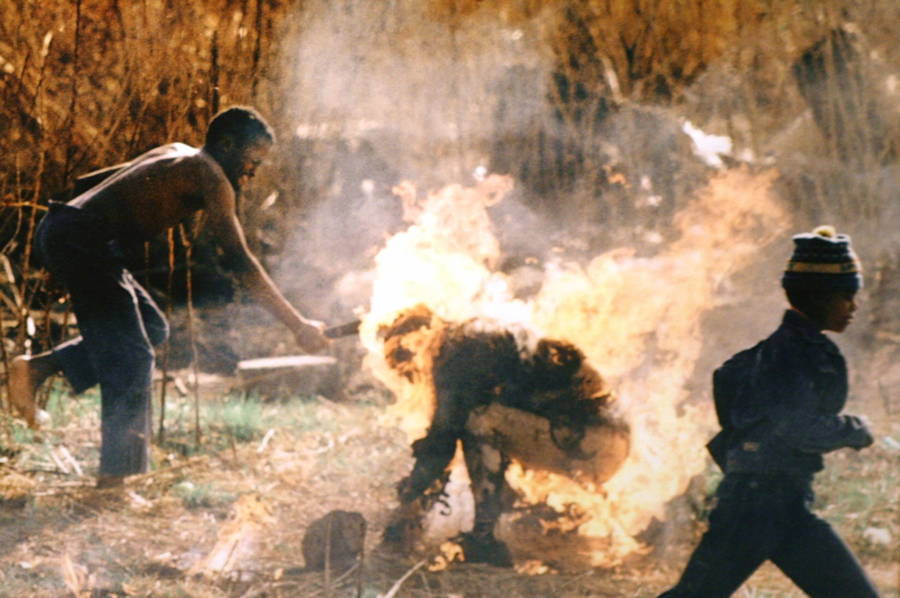
What do you get when desperation meets mob justice?
A burning necklace of horror that leaves behind nothing but ashes and outrage.
Necklacing, a grotesque form of vigilante execution emerged in apartheid-era South Africa as the dark flipside of resistance, and its grim shadow still haunts the nation.
A Method Born of Anger and Despair
For the uninitiated, necklacing isn’t the stylish accessory it sounds like.
It’s a slow, agonizing death.
Here’s how it works: Take a rubber tire, fill it with gasoline, slip it over the victim’s shoulders like an oversized necklace, and set it ablaze. In minutes, the flames consume flesh, leaving behind a grotesque symbol of vengeance.
Necklacing first emerged in the 1980s as apartheid’s chokehold on Black South Africans tightened.
While the world watched the anti-apartheid struggle with admiration, the streets of South Africa bore witness to something much uglier: communities policing themselves when legal systems failed or turned a blind eye.
Who Were the Targets?
Necklacing was often reserved for “sellouts”: those accused of collaborating with the apartheid regime. These could be informants who betrayed liberation fighters to the police or community members seen as sympathetic to the oppressive government.
But like any mob-driven practice, necklacing quickly spiraled out of control. Accusations required no evidence, and grudges or misunderstandings often led to innocent people being burned alive.
If someone pointed a finger and shouted “traitor,” it could be a death sentence.

A Famous Victim: The Amy Biehl Case
Even as apartheid crumbled, the culture of mob justice lingered.
In 1993, an American Fulbright scholar named Amy Biehl was attacked by a mob in Cape Town.
While necklacing wasn’t used in her case, her murder highlighted the same mob mentality that fueled this brutal practice.
The irony? Biehl was a vocal anti-apartheid activist, dedicated to helping oppressed South Africans.

Winnie Mandela’s Infamous Endorsement
One name you can’t ignore in the story of necklacing is Winnie Mandela.
A prominent anti-apartheid activist and then-wife of Nelson Mandela, Winnie made headlines in 1986 with her infamous speech endorsing necklacing.
“With our boxes of matches and our necklaces, we shall liberate this country,” she declared. Her words ignited controversy, with some hailing her as a revolutionary and others condemning her for stoking the flames of brutality, literally.
While she later distanced herself from the practice, the damage was done. Her statement symbolized the moral ambiguity of the liberation struggle, where the lines between heroism and horror blurred dangerously.

The Psychology of the Mob
What drives ordinary people to become executioners?
Sociologists point to the breakdown of trust in formal justice systems during apartheid.
Police were agents of oppression, and courts were kangaroo theaters for upholding racial injustice. Communities, desperate for justice and accountability, took matters into their own hands.
The mob, in its chaotic unity, gave individuals a sense of power and belonging. In the heat of collective anger, restraint and rationality melted away, replaced by a chilling desire for vengeance.
The Media’s Role
Images of necklacing victims, their charred remains captured by photographers, became symbols of the violence tearing South Africa apart.
One photograph in particular, by Kevin Carter, won a Pulitzer Prize but also sparked global outrage.
The haunting image of a young man moments from being necklaced forced the world to confront the brutality of apartheid’s legacy, not just by the regime but also within its opposition.
These images turned necklacing into an international spectacle, fueling debates about whether the anti-apartheid movement was losing its moral compass.
The Decline of Necklacing
As apartheid ended and Nelson Mandela ascended to the presidency in 1994, South Africa began to heal.
Formal justice systems were reformed, and necklacing largely faded into the background. But the practice didn’t disappear entirely.
Even today, sporadic cases of necklacing surface, usually in impoverished communities where vigilante justice still reigns.
In 2022, reports emerged of alleged criminals being necklaced by mobs in rural areas, a grim reminder that the flames of injustice never truly die.
Why Necklacing Lingers
The persistence of necklacing points to deeper issues. South Africa’s democratic transition didn’t magically solve poverty, inequality, or mistrust in the police.
In some areas, crime flourishes, and law enforcement is either absent or complicit. When people feel abandoned by the state, they revert to brutal, medieval forms of justice.
The Emotional Toll
For those who lived through the apartheid era, necklacing remains a source of trauma. Survivors and witnesses often grapple with guilt, anger, and unresolved grief.
For many, it’s not just about the victims but also the moral questions the practice raises: How do you condemn necklacing when the legal system was complicit in oppression? Can justice ever justify such barbarity?
A Cautionary Tale
Necklacing stands as a chilling reminder of what happens when trust in institutions collapses.
It’s a lesson not just for South Africa but for the world: without justice, humanity’s darker instincts can take over. And once the mob takes control, there’s no easy way to put out the fire.
Epilogue: Flames of the Past
Today, necklacing is a relic of South Africa’s turbulent history, but its shadow still lingers in the country’s psyche.
It’s a reminder of the fine line between justice and vengeance, between fighting oppression and becoming the oppressor.
The rubber tires may no longer burn as brightly, but their scars remain etched into history and into the hearts of those who lived it.





